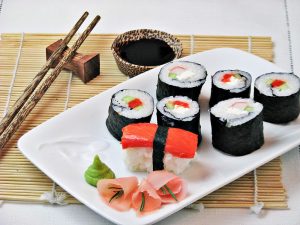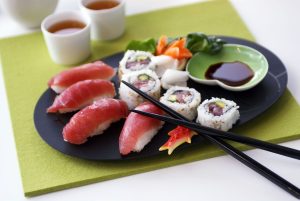Japan
5 Things You Should Know To Eat Sushi Like A Pro
Sushi in India is horribly expensive. That’s a fact that I’ve grudgingly come to accept after many tantrums and moan-fests. Oh, how I long to live in Japan, or Singapore or even New York where sushi is priced the same as regular food. But, since I live in India, I’ve learnt to make the best of my sushi eating experience. If you’re splurging on a nice Japanese dinner, you may as well do it right. These tips will show you how to eat your sushi like a pro, and get the best of your Japanese dining experience.
1) Know your vocabulary

The different varieties of sushi may leave you with question marks floating over your head. Here’s a list of sushi terms that will dissolve some of those question marks:
- Sumeshi: The rice used for making sushi. It is mixed with rice vinegar, salt and sugar. This rice forms the base of all sushi dishes.
- Sushi: Anything made from this vinegared rice.
- Nori: Dried seaweed, used as a wrap
- Red and White fish: The type of meat is obtained from the fish being used to make the sushi. While white meats are mild, red meats are heavier and bolder.
- Nigiri-zushi: This is one of the most popular types of sushi. A thin slice of fish or other seafood is placed on top of a portion of sumeshi.
- Maki-zushi: The word maki means ‘roll’, so maki-zushi has nori rolled around some sumeshi. The centre of the rice holds a stuffing of either vegetables, meat or seafood.
- Sashimi: Sashimi is simply a slice of raw seafood or meat, served plain. Sashimi is not considered a type of sushi.
2) Know your fish
While meat and vegetables are sometimes used in sushi preparations, by far the most popular ingredient in sushi is fish. Here are some common fish cuts of fish used in sushi:
- Akami: This is cut from the back of the tuna fish. The yield is rich and red and tastes similar to a very rare fillet.
- Chu-toro: Also from the tuna, this is from the upper belly and yields fatty slices of fish.
- O-Toro: This is the choicest cut from the tuna from the fattiest part of the tuna’s belly.
- Tai: Cut from red-snapper, a white fish and has a mild taste.
- Hamachi: This is taken from the Japanese Yellow Tail, and has a bold flavour.
- Sake: Salmon, which has a rich taste.
3) Know the process
To get the most out of the flavours in the meal, you should eat your types of sushi in a certain order. This info graphic will show you how.
4) Know your sides
Along with your sushi, you’d have noticed that you get served a dish of soy sauce, a helping of ginger pickle and the infamous wasabi. Here are the commandments for your sides:
- Do not douse your sushi in soy sauce; a small dip will suffice. And always dip the fish side into the sauce, rather than the rice.
- Similarly, do not coat your roll with wasabi. It is meant to enhance, not drown the flavour.
- The ginger pickle is eaten between different types of sushi to cleanse your palate.
5) And finally, enjoy!
This goes for every kind of food you eat; eat it slowly. Savour the taste.
























